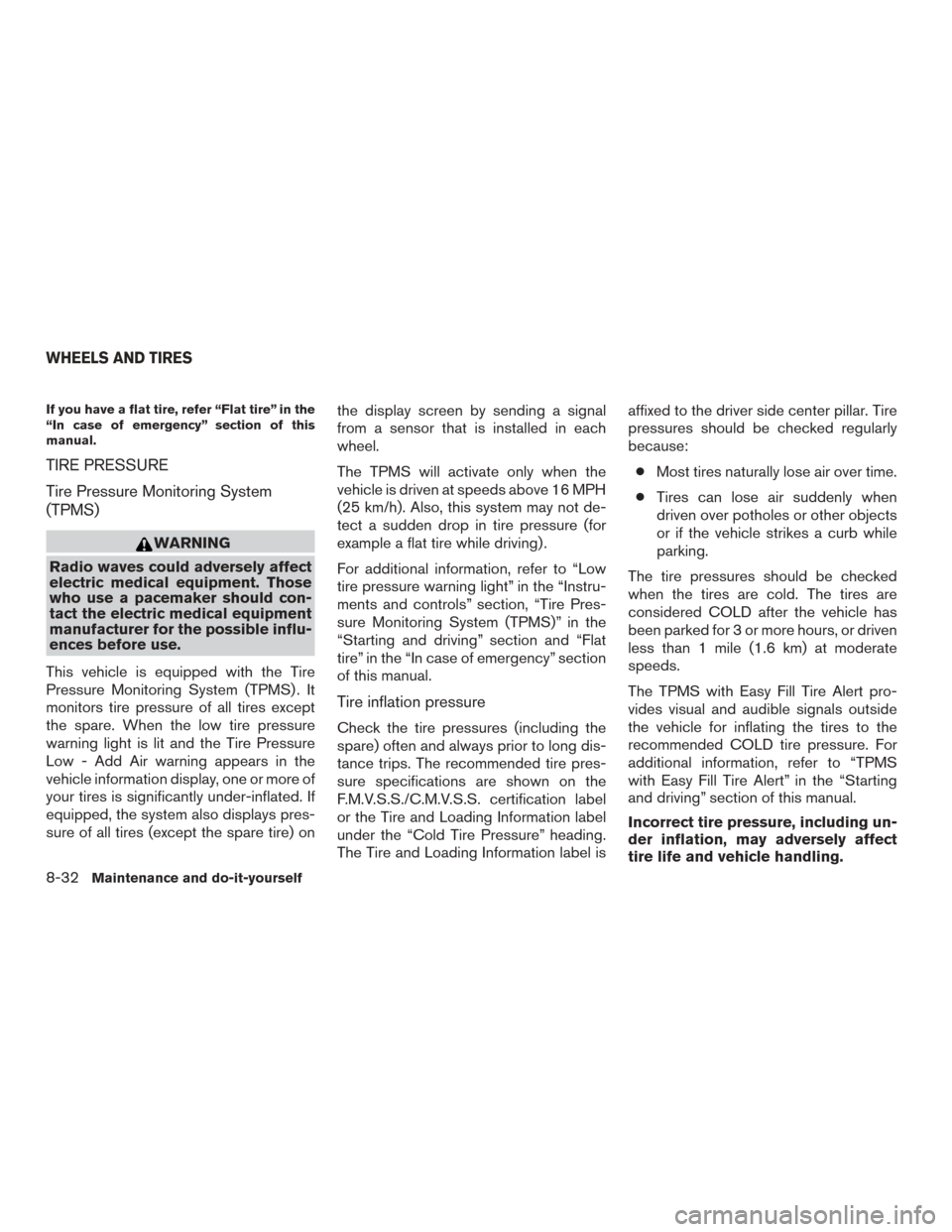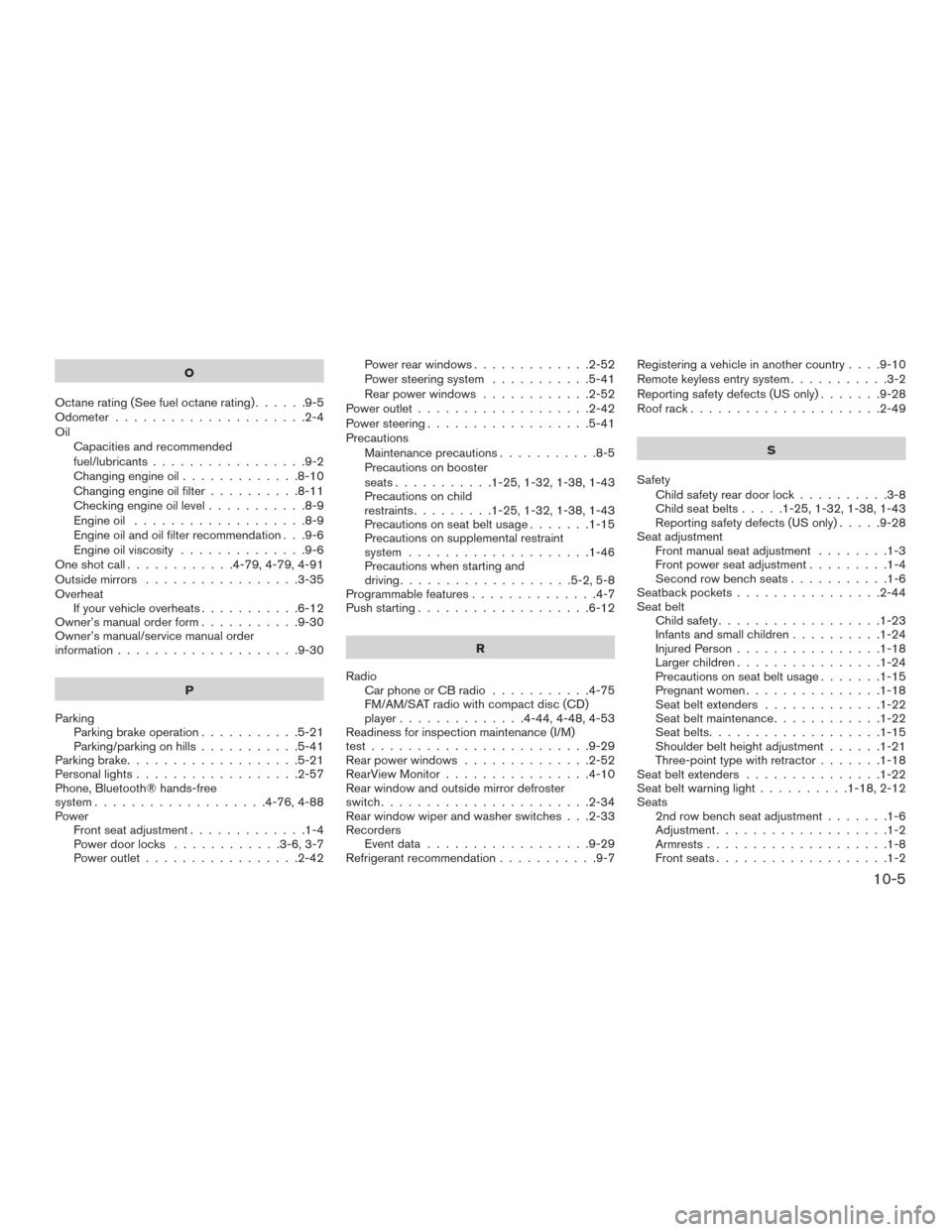2015 NISSAN ROGUE radio
[x] Cancel search: radioPage 389 of 440

If you have a flat tire, refer “Flat tire” in the
“In case of emergency” section of this
manual.
TIRE PRESSURE
Tire Pressure Monitoring System
(TPMS)
WARNING
Radio waves could adversely affect
electric medical equipment. Those
who use a pacemaker should con-
tact the electric medical equipment
manufacturer for the possible influ-
ences before use.
This vehicle is equipped with the Tire
Pressure Monitoring System (TPMS) . It
monitors tire pressure of all tires except
the spare. When the low tire pressure
warning light is lit and the Tire Pressure
Low - Add Air warning appears in the
vehicle information display, one or more of
your tires is significantly under-inflated. If
equipped, the system also displays pres-
sure of all tires (except the spare tire) on the display screen by sending a signal
from a sensor that is installed in each
wheel.
The TPMS will activate only when the
vehicle is driven at speeds above 16 MPH
(25 km/h). Also, this system may not de-
tect a sudden drop in tire pressure (for
example a flat tire while driving) .
For additional information, refer to “Low
tire pressure warning light” in the “Instru-
ments and controls” section, “Tire Pres-
sure Monitoring System (TPMS)” in the
“Starting and driving” section and “Flat
tire” in the “In case of emergency” section
of this manual.
Tire inflation pressure
Check the tire pressures (including the
spare) often and always prior to long dis-
tance trips. The recommended tire pres-
sure specifications are shown on the
F.M.V.S.S./C.M.V.S.S. certification label
or the Tire and Loading Information label
under the “Cold Tire Pressure” heading.
The Tire and Loading Information label isaffixed to the driver side center pillar. Tire
pressures should be checked regularly
because:
● Most tires naturally lose air over time.
● Tires can lose air suddenly when
driven over potholes or other objects
or if the vehicle strikes a curb while
parking.
The tire pressures should be checked
when the tires are cold. The tires are
considered COLD after the vehicle has
been parked for 3 or more hours, or driven
less than 1 mile (1.6 km) at moderate
speeds.
The TPMS with Easy Fill Tire Alert pro-
vides visual and audible signals outside
the vehicle for inflating the tires to the
recommended COLD tire pressure. For
additional information, refer to “TPMS
with Easy Fill Tire Alert” in the “Starting
and driving” section of this manual.
Incorrect tire pressure, including un-
der inflation, may adversely affect
tire life and vehicle handling.
WHEELS AND TIRES
8-32Maintenance and do-it-yourself
Page 432 of 440

10 Index
2nd row bench seat adjustment.........1-6
A
Aiming control, headlights ...........2-36
Air bag (See supplemental restraint
system) .....................1-46
Air bag system Front (See supplemental front impact
air bag system) ...............1-53
Airbagwarninglabels.............1-63
Airbagwarninglight...........1-63,2-12
Air bag warning light, supplemental . .1-63, 2-12
Air cleaner housing filter ............8-17
Air conditioner Air conditioner operation ..........4-28
Air conditioner service ...........4-36
Air conditioner specification label .....9-12
Air conditioner system refrigerant and
oil recommendations .............9-7
Heater and air conditioner
controls................4-25,4-34
Servicing air conditioner ..........4-36
Airflowcharts..................4-29
Alarm system
(See vehicle security system) .........2-29
Anchor point locations .............1-29
Antenna .....................4-74
Antifreeze ....................5-51
Anti-lock brake warning light ..........2-8
Anti-lock Braking System (ABS) ........5-42
Apps .......................4-74 Armrests .....................1-8
AroundView®Monitor.............4-14
Audible reminders
...............2-15
Audio system ..................4-36
AMradioreception.............4-37
Bluetooth®audio..........4-70,4-71
Bluetooth® streaming audio ....4-70,4-71
Compact disc (CD) player . .4-46, 4-51, 4-58
FM/AM/SAT radio with compact disc (CD)
player .............4-44,4-48,4-53
FMradioreception.............4-36
iPod® Player .............4-64,4-67
iPod® player operation .......4-64,4-67
Radio ....................4-36
USB interface ............4-60,4-62
USB (Universal Serial Bus) Connection
Port..................4-60,4-62
Autolight switch .................2-35
Automatic Automatic power window switch .....2-53
Automatic door locks ..............3-7
AUXjack ....................4-60
B
Battery ..................5-51,8-14
Chargewarninglight.............2-9
Battery replacement Keyfob ...................8-24
NISSAN Intelligent Key® ......8-25,8-26
Before starting the engine ...........5-15
Belt (See drive belt) ..............8-16 Block heater
Engine ....................5-53
Bluetooth® audio ............4-70,4-71
Bluetooth® hands-free phone
system..................4-76,4-88
Bluetooth® streaming audio with Navigation
System .....................4-71
Boosterseats..................1-42
Brake Anti-lock Braking System (ABS) ......5-42
Brakelight(Seestoplight).........8-29
Brake system ................5-42
Brakewarninglight..............2-8
Brakewearindicators........2-15,8-21
Parking brake operation ..........5-21
Self-adjusting brakes ............8-21
Brakes ......................8-21
Brake system ..................5-42
Break-inschedule ...............5-35
Brightness/contrast button ...........4-9
Brightness control Instrument panel ..............2-37
Bulb check/instrument panel ..........2-8
Bulbreplacement................8-29
C
Capacities and recommended
fuel/lubricants ...................9-2
C
argolight ...................2-57
Cargo (See vehicle loading information) . . .9-13
Car phone or CB radio .............4-75
Page 436 of 440

O
Octanerating(Seefueloctanerating)......9-5
Odometer .....................2-4
Oil Capacities and recommended
fuel/lubricants .................9-2
Changing engine oil .............8-10
Changing engine oil filter ..........8-11
Checking engine oil level ...........8-9
Engine oil ...................8-9
Engine oil and oil filter recommendation . . .9-6
Engine oil viscosity ..............9-6
Oneshotcall............4-79,4-79,4-91
Outside mirrors .................3-35
Overheat Ifyourvehicleoverheats...........6-12
Owner’s manual order form ...........9-30
Owner’s manual/service manual order
information ....................9-30
P
Parking Parking brake operation ...........5-21
Parking/parking on hills ...........5-41
Parking brake ...................5-21
Personallights..................2-57
Phone, Bluetooth® hands-free
system ...................4-76,4-88
Power Front seat adjustment .............1-4
Power door locks ............3-6,3-7
Power outlet .................2-42 Power rear windows
.............2-52
Power steering system ...........5-41
Rear power windows ............2-52
Power outlet ...................2-42
Power steering ..................5-41
Precautions Maintenance precautions ...........8-5
Precautions on booster
seats...........1-25,1-32,1-38,1-43
Precautions on child
restraints .........1-25,1-32,1-38,1-43
Precautions on seat belt usage .......1-15
Precautions on supplemental restraint
system ....................1-46
Precautions when starting and
driving ...................5-2,5-8
Programmablefeatures..............4-7
Push starting ...................6-12
R
Radio Car phone or CB radio ...........4-75
FM/AM/SAT radio with compact disc (CD)
player ..............4-44,4-48,4-53
Readiness for inspection maintenance (I/M)
test........................9-29
Rear power windows ..............2-52
RearView Monitor ................4-10
Rear window and outside mirror defroster
switch .......................2-34
Rear window wiper and washer switches . . .2-33
Recorders Eventdata..................9-29
Refrigerant recommendation ...........9-7Registering a vehicle in another country
....9-10
Remote keyless entry system ...........3-2
Reporting safety defects (US only) .......9-28
Roof rack .....................2-49
S
Safety Child safety rear door lock ..........3-8
Child seat belts .....1-25,1-32,1-38,1-43
Reporting safety defects (US only) .....9-28
Seat adjustment Front manual seat adjustment ........1-3
Front power seat adjustment .........
1-4
Secondrowbenchseats...........1-6
Seatbackpockets................2-44
Seat belt Child safety ..................1-23
Infants and small children ..........1-24
Injured Person ................1-18
Largerchildren................1-24
Precautions on seat belt usage .......1-15
Pregnant women ...............1-18
Seatbeltextenders .............1-22
Seatbeltmaintenance............1-22
Seatbelts...................1-15
Shoulder belt height adjustment ......1-21
Three-point type with retractor .......1-18
Seat belt extenders ...............1-22
Seatbeltwarninglight..........1-18,2-12
Seats 2nd row bench seat adjustment .......1-6
Adjustment ...................1-2
Armrests....................1-8
Frontseats...................1-2
10-5